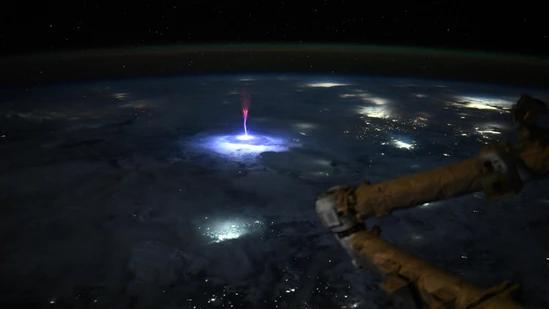
NASA Astronaut Captures Rare ‘Sprite’ Lightning over US & Mexico
In a remarkable sighting, NASA astronaut Nichole Ayers has captured a rare and breathtaking image of a ‘sprite’ lightning phenomenon while orbiting above the United States and Mexico from the International Space Station.
The stunning photograph, taken by Ayers, showcases a brief burst of light above a thunderstorm, a phenomenon known as a ‘sprite’. These Transient Luminous Events (TLEs) are rare and short-lived, occurring when a strong electrical discharge from a thunderstorm interacts with the Earth’s atmosphere.
Sprites are a fascinating aspect of atmospheric science, and NASA astronauts like Ayers have the unique privilege of capturing these events from space. The International Space Station, orbiting the Earth at an altitude of around 250 miles, provides an unparalleled vantage point for observing these fleeting occurrences.
Ayers shared the picture on social media, stating, “I’m thrilled to share this rare capture of a ‘sprite’ lightning phenomenon over the US and Mexico! Scientists can use these types of photos to better understand the relationship of TLEs to thunderstorms.” Her post has sparked a flurry of interest among science enthusiasts and space fans worldwide.
Sprites are a type of TLE, which includes other rare atmospheric events like “blue jets” and “giant jets”. These brief bursts of light are caused by electrical discharges that occur when a thunderstorm’s electrical activity interacts with the ionosphere, a layer of the atmosphere extending from about 50 to 600 miles above the Earth’s surface.
In Ayers’ photograph, the sprite appears as a bright, wispy streak of light above the clouds, illuminated against the dark background of space. The image provides a unique glimpse into the dynamic interactions between the Earth’s atmosphere and the electrical discharges that occur during thunderstorms.
Ayers’ capture is not only a testament to the astronaut’s exceptional photography skills but also highlights the importance of space-based observations in advancing our understanding of atmospheric science. The International Space Station, with its unique vantage point and advanced scientific equipment, has enabled scientists to study the Earth’s atmosphere in unprecedented detail.
By capturing rare events like sprites, NASA astronauts like Ayers contribute significantly to our understanding of the complex relationships between thunderstorms, lightning, and the upper atmosphere. These observations have far-reaching implications for the development of more accurate weather forecasting models and a better understanding of the Earth’s climate system.
Ayers’ photograph has sparked a renewed interest in the study of TLEs and sprites, with scientists and researchers eager to analyze the data and learn more about these enigmatic atmospheric events. As we continue to explore the wonders of the universe, astronauts like Ayers play a vital role in advancing our understanding of the Earth’s atmosphere and the complex phenomena that occur within it.






